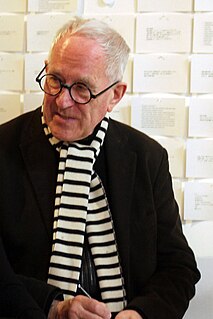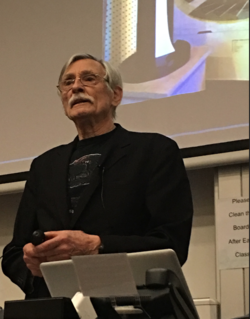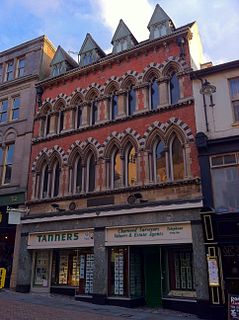
Henry Graham Greene, professionally known as Graham Greene, was an English novelist regarded by many as one of the leading English novelists of the 20th century. Combining literary acclaim with widespread popularity, Greene acquired a reputation early in his lifetime as a major writer, both of serious Catholic novels, and of thrillers. He was shortlisted, in 1966 and 1967, for the Nobel Prize for Literature. Through 67 years of writings, which included over 25 novels, he explored the ambivalent moral and political issues of the modern world, often through a Catholic perspective.
Sir Michael John Hopkins is an English architect.
The year 2002 in architecture involved some significant architectural events and new buildings.
The year 1961 in architecture involved some significant architectural events and new buildings.

Archigram was an avant-garde architectural group formed in the 1960s that was neofuturistic, anti-heroic and pro-consumerist, drawing inspiration from technology in order to create a new reality that was solely expressed through hypothetical projects.

Sir Peter Cook is an English architect, lecturer and writer on architectural subjects. He was a founder of Archigram, and was knighted in 2007 by the Queen for his services to architecture and teaching. He is also a Royal Academician and a Commandeur de l'Ordre des Arts et des Lettres of the French Republic. His achievements with Archigram were recognised by the Royal Institute of British Architects in 2004, when the group was awarded the Royal Gold Medal.

Blobitecture, blobism and blobismus are terms for a movement in architecture in which buildings have an organic, amoeba-shaped, building form. Though the term blob architecture was in vogue already in the mid-1990s, the word blobitecture first appeared in print in 2002, in William Safire's "On Language" column in the New York Times Magazine in an article entitled "Defenestration". Though intended in the article to have a derogatory meaning, the word stuck and is often used to describe buildings with curved and rounded shapes.

Neo-futurism is a late-20th- to early-21st-century movement in the arts, design, and architecture. It has been seen as a departure from the attitude of post-modernism and represents an idealistic belief in a better future.
Megastructure is an architectural and urban concept of the post-war eras which envisions a city or an urban form that could be encased in a massive single man-made structure or a relatively small number of interconnected structures. In a megastructural project, orders and hierarchies are created with large and permanent structures supporting small and transitional ones.
Simon Sadler is a Professor in the Department of Design and in the Art History Program at the University of California, Davis. His publications focus on histories, theories and ideologies of architecture, design and urbanism since the mid-twentieth century, and include studies of the Archigram group, the Situationists, and counterculture.
Colin Fournier is co-architect with Peter Cook of the Kunsthaus Graz in Austria. Educated at the Architectural Association, Fournier was a founding member of Archigram.
Bowellism is a modern architectural style heavily associated with Richard Rogers. It is described as a transient architectural and flippant style that was influenced by Le Corbusier and Antoni Gaudi.

Massimiliano Fuksas is an Italian architect. He is the head of Studio Fuksas in partnership with his wife, Doriana Mandrelli Fuksas, with offices in Rome, Paris and Shenzhen.

The Oxford School of Architecture was founded in 1927. Forming part of the Oxford City Technical School, this became the Oxford College of Technology in 1956, the Oxford Polytechnic in 1970 and Oxford Brookes University in 1992. Now called the School of Architecture in the Faculty of Technology, Design & the Environment, it is one of the largest architecture schools in the UK, with around 600 students and 70 staff. The school has become one of the most competitive architecture schools, ranking in the top 50 Architecture schools in the world in the 2015 QS World University Rankings.
David Rock is an English architect and graphic designer, twice RIBA vice-president and RIBA president (1997–99).

Michael Webb is an English architect. He was a founding member of the 1960s Archigram Group.
Ronald James "Ron" Herron was a notable English architect and teacher. He was perhaps best known for his work with the seminal English experimental architecture collective Archigram, which was formed in London in the early 1960s. Herron is the creator of one of the group's best known and celebrated projects, the walking city.

The Nottingham Journal was a newspaper published in Nottingham, Nottinghamshire, in the East Midlands in England. During that time, the paper went through several title changes through mergers, take-overs, acquisitions and ownership changes.
Dennis Crompton is an English architect, lecturer and writer on architectural subjects. He was a member of Archigram. He was known as the back-room fixer dealing with technology and looking after the archives of the group.
Warren Chalk (1927–1988) was an English architect. He was a member of Archigram. Amongst the group he was known as "the catalyst of ideas".








